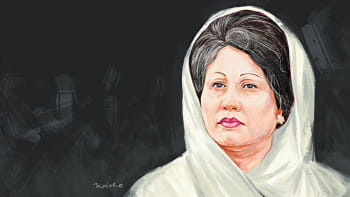Covid-19 and SDG 9: Strengthening infrastructure and innovation

On February 3, 2020, Huoshenshan Hospital, an emergency specialty field hospital covering an area of 34,000 square metres and containing 1,000 beds, opened its doors for the treatment of Covid-19 patients in Wuhan, China. Just 10 days earlier, five road rollers, 33 bulldozers, 95 excavators, 160 dump trucks, 160 management personnel and 240 workers had started working on the hospital's construction site. Halfway across the world, the United States Navy's hospital ships "USNS Mercy" and "USNS Comfort"—each with a capacity of 1,000 beds—were deployed in Los Angles and New York on March 27 and 30, respectively, to ease the pressure of Covid-19 patients on regular hospitals. These examples show how rapidly constructed infrastructure projects, as well as innovative ideas, can help fight the onslaught of the Covid-19 pandemic.
Sustainable Development Goal (SDG) 9 calls upon countries to "build resilient infrastructure, promote inclusive and sustainable industrialisation, and foster innovation". Unfortunately, the infrastructure required for successful industrialisation and innovation in Bangladesh is inadequate, particularly in rural areas where infrastructure deficiencies are acute. Glaring inequalities are present in terms of access to modern technological infrastructure such as high-speed broadband internet. Efforts to fill in the infrastructure gap with a plethora of projects have been only partly successful due to our weak implementation capacity. Cost and time overruns in fast-track mega projects have reduced the efficacy of public investment, creating fiscal pressure and impeding private investment. Although Bangladesh has a good debt servicing record, debt sustainability may become an issue in the future, especially in the case of large infrastructure projects that are being financed from foreign sources.
SDG target 9.2 asserts the need to double industry's share in employment and gross domestic product (GDP) in the Least Developed Countries by 2030. Industrialisation in Bangladesh, as measured by the growth of share of manufacturing in GDP, had been stagnant at around 15 percent during the years 1996-2005. However, since 2006, the share of manufacturing in GDP has been growing steadily every year, with the pace of growth picking up after 2010. In 2018, the share of manufacturing in GDP stood at 22.85 percent. Thus, the country had already achieved the milestone of having manufacturing value-added equal to at least 21.5 percent of GDP even before 2020.
Despite the sluggish pace of industrialisation, the economy of Bangladesh has still undergone significant structural change. The International Labour Organization's modelled estimates suggest that the share of workers employed in the agriculture sector decreased from 65 percent in 1999 to 39.7 percent in 2019. On the other hand, the share of workers employed in the industry sector almost doubled from 10.4 percent in 1999 to 20.5 percent in 2019. Nonetheless, there are concerns about premature de-industrialisation of the Bangladesh economy. Such apprehension is confirmed by the fact that the share of workers employed in the services sector increased from 24.6 percent in 1999 to 39.8 percent in 2019. Thus, Bangladesh's economy, like those of other South Asian countries, has managed to undergo a shift directly from agriculture to services.
Industry-led structural transformation can play a key role in generating employment and alleviating poverty. An industry sector that makes use of labour-intensive production technology could absorb the enormous numbers of youth entering Bangladesh's labour market every year, and ensure that the economic growth is pro-poor. Therefore, employment in the manufacturing sector is an issue that demands attention of the policymakers.
Worldwide, Covid-19 has created a huge setback for the manufacturing and transportation sectors of the economy, triggering instability in distribution chains and food supply and causing unemployment and underemployment. In the first quarter of 2020, manufacturing output fell by 6 percent globally, and by 14.1 percent in China. Manufacturing in Bangladesh has also taken a blow since the start of the pandemic, which has led to serious repercussions throughout the economy. The United Nations Department of Economic and Social Affairs (UNDESA) estimates indicate that Bangladesh's ready-made garments (RMG) exports in April 2020 fell by 80 percent compared to April 2019, and one million RMG workers, who were largely women, were either fired or furloughed. Another study by the World Bank has shown that 19 percent of female garment workers in Bangladesh lost their jobs between March 25 and September 15 in 2020. Bangladesh's RMG export orders valued at more than USD 3 billion were cancelled due to the pandemic.
However, since the Covid-19 pandemic still remains as an evolving situation, it is difficult to ascertain how short-lived or long-lasting its shocks will be. If history is any indicator of the future, it is likely that the resilience and tenacity of the economy and people of Bangladesh will overcome the Covid-19 crisis, just like many others in the past.
A number of steps need to be taken to steer Bangladesh in its path towards recovery from Covid-19 and achievement of SDG 9. Longstanding non-operational projects should be delisted from the Annual Development Programme (ADP). The practice of providing symbolic allocation to keep inefficient projects running should be stopped. Feasibility studies that include comprehensive cost-benefit analysis should be made mandatory for all projects, and all project feasibility reports should be made publicly available. Industrial policies should be designed to encourage economic diversification in order to reduce vulnerability to shocks. The power of technology should be harnessed in order to improve productivity and increase the complexity of exports. An enabling environment needs to be created that will facilitate investment and support the placement of domestic producers into global value chains. These measures, inter alia, will be conducive towards recovering from Covid-19 and implementing SDG 9 in Bangladesh by 2030.
Syed Yusuf Saadat is a Senior Research Associate at the Centre for Policy Dialogue (CPD).
Email: [email protected]

 For all latest news, follow The Daily Star's Google News channel.
For all latest news, follow The Daily Star's Google News channel. 



Comments